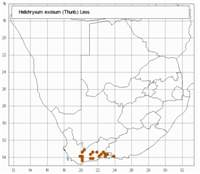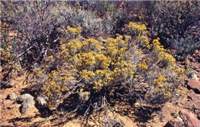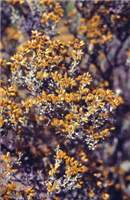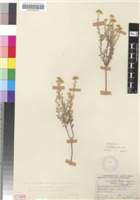Origin of name:
excisus = cut out, referring to the squarrose bracts
Diagnostic characters:
Densely branched shrubsBright yellow bractsGrey spathulate leaves with emarginate tipsCompact to open inflorescence
Description:
Densely twiggy dwarf shrub up to 450 mm tall, very aromatic, old branches bare, rough with persistent leaf bases, twigs short, stiff, thinly grey-felted, closely leafy. Leaves suberect to spreading, 5-8 x 2-3 mm, thickish, spathulate, much narrowed to the base, very shortly decurrent, apex mucronate, recurved, both surfaces grey-felted. Heads homogamous, turbinate-cylindric, c. 4 x 2.5 mm, few in terminal corymbose clusters, often further aggregated. Involucral bracts in 6 series, graded, imbricate, inner slightly exceeding the flowers, lanceolate, acute, tips squarrose, some woolly hairs dorsally on shafts, outer golden sometimes tinged golden-brown, inner bright canary-yellow. Receptacle smooth or very shortly toothed. Flowers 7-11. Achenes not seen, ovaries with myxogenic hairs. Pappus bristles many, scabrid, tips barbellate, bases cohering strongly by patent cilia.
Flowering between November and February.
Distribution:
On hills and mountain slopes. Recorded from Montagu, Bredasdorp, Ladismith, Riversdale, Oudtshoorn and Willowmore degree squares.
Fynbos Biome.
Notes:
Easily recognized by its small grey spathulate leaves and small heads with bright yellow squarrose bracts.
Taxonomy:
Literature:
Helichrysum excisum (Thunb.) Less., Syn. Comp. 282 (1832); DC., Prodr. 6: 192 (1838); Harv. in F.C. 3: 237 (1865); Moeser in Bot. Jb. 44: 291 (1910).
Type:
Cape of Good Hope, Thunberg (sheet 19153, UPS, holo.).
Synonym(s):
Gnaphalium excisum Thunb., Prodr. 151 (1800), Fl. Cap. 655 (1823).
Vouchers:
Acocks 23102 (PRE); Bolus 1053 (BM; BOL; SAM); Compton 10544 (NBG); Rogers 17893 (PRE; SAM); Stokoe in SAM 54699 (SAM).



